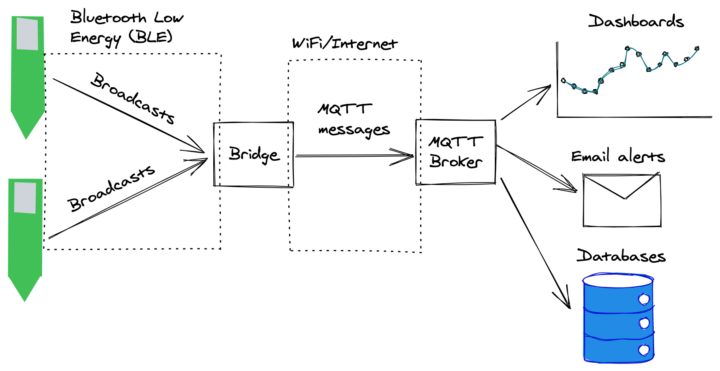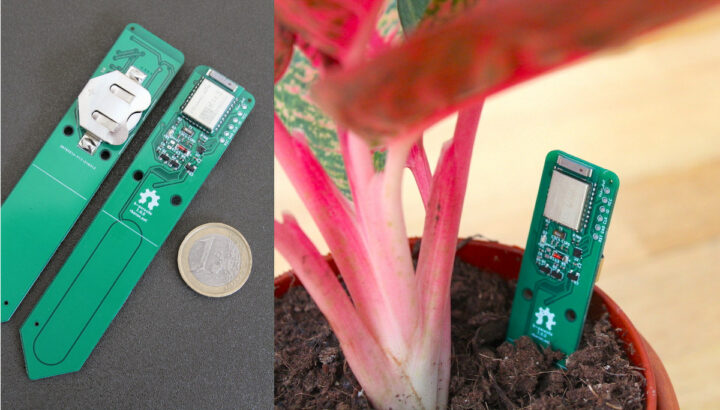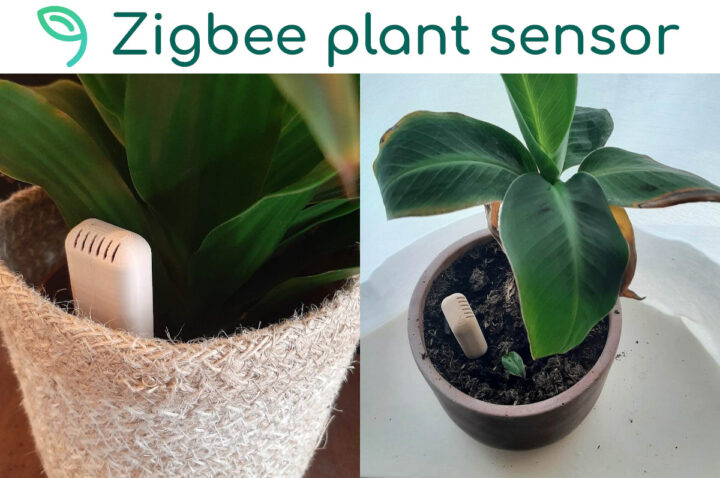rbaron’s b-parasite is an open-source hardware Bluetooth LE plant watering sensor that can measure soil moisture and ambient temperature/humidity/light and works with ESPHome, Home Assistant, or any macOS or Linux platforms including the Raspberry Pi boards.
It is based nRF52840 multi-protocol wireless microcontroller, so stanvn decided to add Zigbee support to the b-parasite through the “Zigbee Plant Sensor” firmware based on the Nordic Semi nRF5 SDK for nRF52 series of SoCs and working with Zigbee2MQTT.
Let’s have a look at b-parasite hardware specifications first:
- Wireless MCU – Nordic Semi nRF52840 Arm Cortex-M4F multi-protocol wireless microcontroller with Bluetooth LE 5.0 and 802.15.4 (Zigbee/Thread) radios, 1024 KB flash, 256KB SRAM
- Sensors
- Capacitive soil moisture sensor
- Sensirion SHTC3 temperature and humidity sensor
- ALS-PT19 light sensor
- Power – ~200 mAh CR2032 coin-cell battery estimated to last for a couple of years with readings every 10 minutes
The GitHub repository for the board contains the KiCad schematic, layout and fabrication files, the firmware code based on the nRF5 SDK, data for testing and sensor calibration, an ESPHome-based BLE to MQTT bridge, and a 3D printable case, as well as instructions.

With the default firmware the b-parasite plant sensor will periodically measure the soil moisture, light intensity, air temperature & humidity and transmit those values via Bluetoooth LE to a BLE to MQTT gateway such as the GL.INet GL-S10 we tested earlier this year, and the data would then be forwarded to the cloud for processing there. Once the data has been transmitted to the BLE to MQTT bridge, the device goes into deep sleep until the next measurement.
The documentation also mentions three methods of integration:
- ESPHome firmware acting as a BLE-MQTT bridge on supported ESP32 boards. The b-parasite sensor is officially supported with detailed documentation so it should be fairly easy to use.
- Home Assistant integration works through the ble_monitor Home Assistant custom component that automatically discovers nearby b-parasites based on their advertisement data.
- Linux (Raspberry Pi) & macOS when running the parasite-scanner BLE to MQTT bridge daemon specifically designed for b-parasite sensors.
But as noted in the introduction, it’s now possible to convert the b-parasite Bluetooth LE device into a Zigbee plant sensor with stanvn’s open-source firmware. It is shown above housed in a 3D printed case. The Zigbee plant sensor firmware supports all sensors in the hardware and works with Zigbee2MQTT meaning integration with Home Assistant and other home automation frameworks should be fairly easy. Battery life was estimated to be around 600 days with measurements and transmission every 2 minutes.
One downside of the current hardware is the lack of a factory reset button, so stanvn is also working on his own hardware. There are no details at this time, but he asks interested people to fill out a form to register their interest and be contacted once the hardware becomes available, but it looks like he might also launch it on Crowd Supply. If you are interested in battery-powered plant sensors in general, you may want to check out a long discussion about this topic on Home Assistant forums.
Thanks to Hedda for the tip.

Jean-Luc started CNX Software in 2010 as a part-time endeavor, before quitting his job as a software engineering manager, and starting to write daily news, and reviews full time later in 2011.
Support CNX Software! Donate via cryptocurrencies, become a Patron on Patreon, or purchase goods on Amazon or Aliexpress






